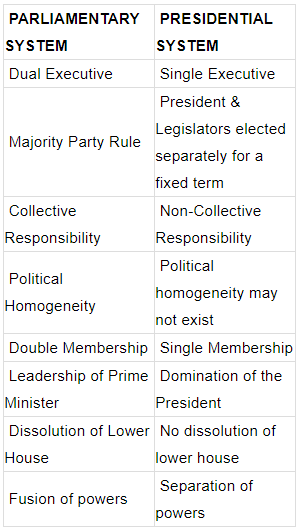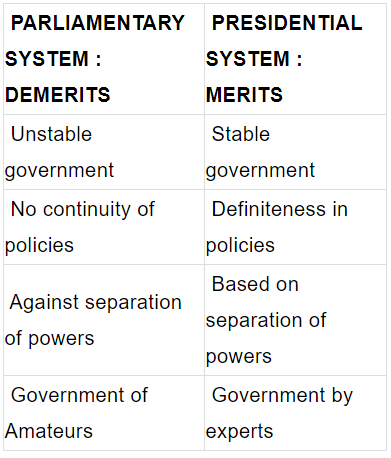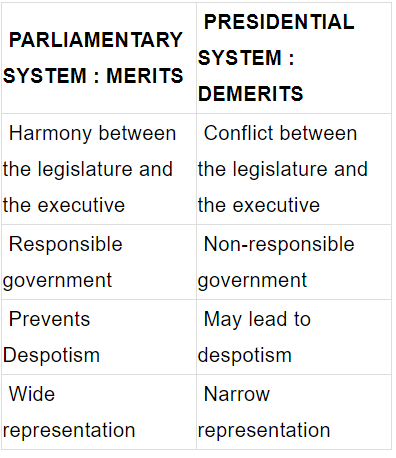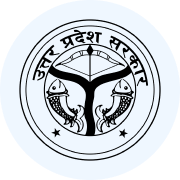Laxmikant Summary: Parliamentary System- 2 | Environment & Social Studies for Super TET PDF Download
INTRODUCTION
≫ The relationship between the executive and the legislature is the basis for classification of democracies as parliamentary or presidential.
≫ Presidential: executive is independent
≫ Parliamentary: executive is responsible to the legislature
≫ Parliamentary: aka Cabinet government, responsible government, Westminster model, prime ministerial government
- Britain, Japan, Canada, India
≫ Presidential: non-responsible, non-parliamentary, fixed executive system
- USA, Brazil, Russia, Sri Lanka
INDIA'S SYSTEM
≫ Parliamentary System
≫ Enshrined in Article 74 and 75 for the Centre
- Article 74: Council of Ministers to aid and advise the President
- Article 75: Other provisions as to ministers
≫ Articles 163 and 164 for the states
- Article 163: Council of ministers to aid and advise the Governor
- Article 164: Other provisions as to ministers
≫ India chose the Parliamentary system because
- India was familiar with it
- Preference for more responsibility, which is given by the Parliamentary system (while Presidential system gives more stability, but less responsibility)
- Need to avoid legislative-executive conflicts to conserve an infant democracy.
- Parliamentary system gives more scope for representation, which is apt for India diverse population.
- Swaran Singh Committee studied in the 1970's if the Parliamentary system should be replaced by the Presidential system in India. 1975 report recommended that there was no need for change on this account.
FEATURES OF PARLIAMENTARY GOVERNMENT
≫ Nominal and Real Executives
a. Nominal: de jure, titular
- President
b. Real: de facto
- Prime Minister
(Article 74 says that advice of the council of ministers, led by the Prime Minister is binding on the President)
≫ Majority Party Rule
≫ Collective Responsibility
- Ministers are collectively responsible to the Lok-Sabha (Article 75)
- They can be removed if the Lok-Sabha passes a vote of no-confidence
≫ Political Homogeneity: members of the council of ministers usually belong to the same political party (unless its a coalition government)
≫ Double membership: ministers are members of both the executive and the legislature.
≫ Leadership of the Prime Minister, which gives him a crucial role in the govt.
≫ Dissolution of the Lok-Sabha before the end of its term
- Possible on recommendation of the Prime Minister to the President
- The executive enjoys the right to get the legislature dissolved in a parliamentary system
≫ Secrecy: Ministers take an oath of secrecy before entering office, administered by the President
- They cannot divulge information about their proceedings, policies and decisions
FEATURES OF PRESIDENTIAL GOVERNMENT
The American System has the following features:
≫ President is both head of state and head of government. Ceremonial head as well as leaders of the executive.
≫ Elected for a fixed tenure of four years. Cannot be removed except by impeachment by the Congress for a grave unconstitutional act.
≫ Governs with the help of a smaller, Kitchen Cabinet.
- only an advisory body
- Non-elected departmental secretaries
- Selected and appointed by him
- Responsible only to him
- Can be removed by him at any time
- Not members of the legislature
≫ President and his secretaries are not responsible to the legislature.
- They neither possess membership of the Congress nor attend its meetings.
≫ President cannot dissolve the lower House of the Congress.
≫ Based on the principle of separation of powers. The legislative, executive and judicial powers of the govt are separated and vested in 3 independent organs of the govt.
MERITS OF THE PARLIAMENTARY SYSTEM
≫ Harmony between the Legislature and the Executive
- Greatest advantage of the Parliamentary system
- Executive is a part of the legislature, and both are interdependent
≫ Responsible government: Parliament holds the executive accountable through devices like the question house, discussions, adjournment motions etc.
≫ Prevents despotism as authority is vested in a group of individuals (the council of ministers) and not a single person. This, disposal of authority checks the dictatorial tendencies of the executive. Moreover, the executive is responsible to the parliament and can be removed by a No-Confidence motion.
Ready alternative government are the head of the state can invite the opposition party to form the government in case the ruling party loses its majority. This means an alternative government can be formed without fresh elections. Hence, Dr Jennings said, "The leader of opposition is the alternative PM".
≫ Wide representation through the executive, as ministers are representatives of the people as well.
DEMERITS OF THE PARLIAMENTARY SYSTEM
≫ Unstable government
- No guarantee that government will survive its tenure
- No-confidence motion, political defection, coalitions etc.
≫ No continuity of policies
- A change in the ruling party is generally followed by changes in policies of the government.
≫ Dictatorship of the Cabinet
- Especially when ruling party enjoys absolute majority in the Parliament
≫ Against separation of powers
- In it, the legislature and the executive are together and inseparable. The cabinet acts as the leader of the legislature as well as the executive. Bagchot points out, "The Cabinet is a hyphen that joins the buckle that binds the executive and legislative departments together". Hence, the whole system of govt goes against the letter and spirit of the theory of separation of powers. In fact, there is a fusion of powers.
≫ Government by amateurs
- Ministers are not experts in their fields. The PM has a limited choice in the selection of ministers; his choice is restricted to MPs alone and does not extend to external talent. Moreover, the ministers devote most of their time to parliamentary work, cabinet meetings and party activities.
INDIAN AND BRITISH SYSTEM
Difference with the British System:
≫ India a republic. Britain a Constitutional Monarchy.
≫ Parliament is supreme in Britain. India's Parliament is restricted by a written constitution, federal system, judicial review and fundamental rights.
≫ British Prime Minister has to be a member of the Lower House. Indian Prime Minister can belong to any House of the Parliament.
≫ Only members of Parliament can be appointed as ministers in Britain. In India, anyone can be appointed for maximum six months.
≫ Britain's ministers have legal responsibility for official acts. Indian's ministers are not required to countersign the official acts of the head of the State.
≫ Shadow Cabinet: Unique British institution
- Opposition party members form it to balance the ruling cabinet and to prepare its members for future ministerial office.
- No such institution in India
COMPARING THE PARLIAMENTARY AND PRESIDENTIAL SYSTEM
≫ Features of Parliamentary and Presidential System
≫ Demerits of Parliamentary and merits Presidential system
≫ Merits of Parliamentary and demerits Presidential System
|
205 videos|283 docs|68 tests
|
FAQs on Laxmikant Summary: Parliamentary System- 2 - Environment & Social Studies for Super TET
| 1. What is a parliamentary system? |  |
| 2. How does a parliamentary system differ from a presidential system? |  |
| 3. What are the advantages of a parliamentary system? |  |
| 4. How does a parliamentary system ensure checks and balances? |  |
| 5. Which countries have a parliamentary system? |  |
|
205 videos|283 docs|68 tests
|

|
Explore Courses for Super TET exam
|

|


















